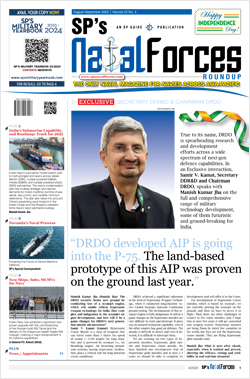INDIAN ARMED FORCES CHIEFS ON OUR RELENTLESS AND FOCUSED PUBLISHING EFFORTS

The insightful articles, inspiring narrations and analytical perspectives presented by the Editorial Team, establish an alluring connect with the reader. My compliments and best wishes to SP Guide Publications.

"Over the past 60 years, the growth of SP Guide Publications has mirrored the rising stature of Indian Navy. Its well-researched and informative magazines on Defence and Aerospace sector have served to shape an educated opinion of our military personnel, policy makers and the public alike. I wish SP's Publication team continued success, fair winds and following seas in all future endeavour!"

Since, its inception in 1964, SP Guide Publications has consistently demonstrated commitment to high-quality journalism in the aerospace and defence sectors, earning a well-deserved reputation as Asia's largest media house in this domain. I wish SP Guide Publications continued success in its pursuit of excellence.
Spotliight
Anti-Sub Corvette Kadmatt Launched

The Indian Navy’s modernisation quest under Project-28 to stealthily hunt and destroy lurking enemy submarines got a further boost recently with the launch of the second indigenous anti-submarine warfare (ASW) corvette Kadmatt named after an island in Lakshwadeep.
The corvette built by the Garden Reach Shipbuilders & Engineers (GRSE), Kolkata, was launched by Mamatha M, wife of the Minister of State for Defence M.M. Pallam Raju in the presence of the Controller of Warship Production and Acquisition of the Indian Navy Vice Admiral N.N. Kumar and GRSE Chairman and Managing Director Rear Admiral K.C. Sekhar.
GRSE is to launch four P28 corvettes at a cost of Rs. 37.3 crore. Kamorta was the first to be launched on April 19, 2010, and after fitments is expected to be delivered to the Indian Navy in June 2012 and Kadmatt in March 2013. The remaining two are Kiltan and Kavaratti. The Kamorta class corvettes are capable of fighting in a nuclear, biological and chemical environment. The 109-metrelong, 12.8-metre-wide ship with an approximate displacement capacity of 3,000 tonnes can achieve a maximum speed of 25 knots. Powered by four 3,888 kW diesel engines, it can cover nearly 3,450 nautical miles at 18 knots, carrying a helicopter. The ship having indigenous weapon and sensor suites is equipped with super-rapid gun mounting, anti-aircraft guns, torpedo launcher, rocket and chaff launchers.





